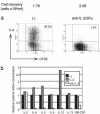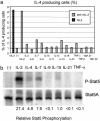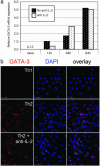Interleukin 2 plays a central role in Th2 differentiation
- PMID: 15004274
- PMCID: PMC374338
- DOI: 10.1073/pnas.0400339101
Interleukin 2 plays a central role in Th2 differentiation
Abstract
Differentiation of naïve CD4 T cells into T helper (Th) 2 cells requires signaling through the T cell receptor and an appropriate cytokine environment. IL-4 is critical for such Th2 differentiation. We show that IL-2 plays a central role in this process. The effect of IL-2 on Th2 generation does not depend on its cell growth or survival effects. Stat5a(-/-) cells show diminished differentiation to IL-4 production, and forced expression of a constitutively active form of Stat5a replaces the need for IL-2. In vivo IL-2 neutralization inhibits IL-4 production in two models. Studies of restriction enzyme accessibility and binding of Stat5 to chromatin indicate that IL-2 mediates its effect by stabilizing the accessibility of the Il4 gene. Thus, IL-2 plays a critical role in the polarization of naive CD4 T cells to the Th2 phenotype.
Figures







References
-
- Zheng, W. & Flavell, R. A. (1997) Cell 89, 587-596. - PubMed
-
- Ouyang, W., Ranganath, S. H., Weindel, K., Bhattacharya, D., Murphy, T. L., Sha, W. C. & Murphy, K. M. (1998) Immunity 9, 745-755. - PubMed
-
- Henkel, G., Weiss, D. L., McCoy, R., Deloughery, T., Tara, D. & Brown, M. A. (1992) J. Immunol. 149, 3239-3246. - PubMed
-
- Bird, J. J., Brown, D. R., Mullen, A. C., Moskowitz, N. H., Mahowald, M. A., Sider, J. R., Gajewski, T. F., Wang, C. R. & Reiner, S. L. (1998) Immunity 9, 229-237. - PubMed
-
- Takemoto, N., Koyano-Nakagawa, N., Yokota, T., Arai, N., Miyatake, S. & Arai, K. (1998) Int. Immunol. 10, 1981-1985. - PubMed
MeSH terms
Substances
LinkOut - more resources
Full Text Sources
Other Literature Sources
Research Materials
Miscellaneous

